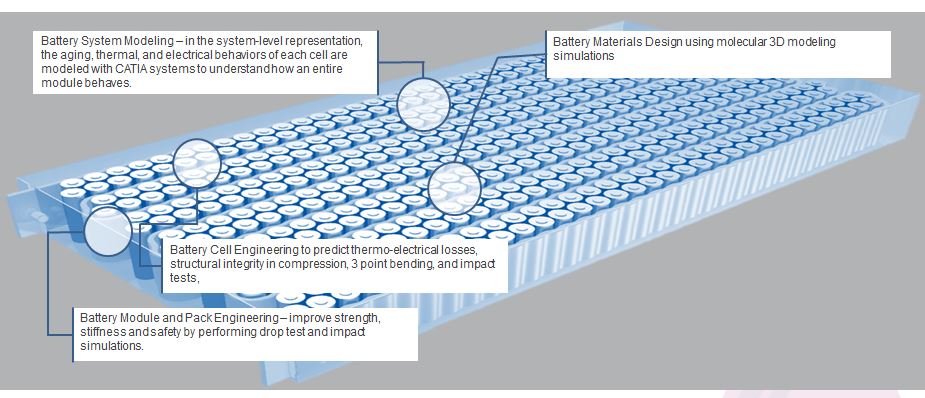BATTERY ENGINEERING
In today’s fast paced world, there is lot of competition to bring out the best, safest, durable and cost effective products. Due to increasing competition, industries are not only delivering physical products, but a lot of effort goes into concept study and simulations. One way to address the tremendous competition is to perform virtual prototyping with multi-scale simulation, be it structural, thermal, fluid, electromagnetic at all the stages of product development cycle.
Today the global industry is shifting towards more hybrid and electric vehicles (EV). One important aspect of any electric system is the battery. The world of batteries is much different today than it used to be. Until a few years ago, they were mainly used to power portable electronic devices. Today they are used in much more harsh conditions and are getting bigger and bigger.
As an integral part of EV, the batteries are exposed to harsh conditions, be it exposure to wide range of temperature, or moved around, shake, charged & discharged in irregular cycles etc. In EV, they are required to be storing more energy and power and hence they are getting bigger and in turn poses much more risks.

BATTERY CELL/ MODULE ENGINEERING
Batteries are an integral part for any electric vehicles. With the pressure to maximize the range, maintain safety and store as much energy as possible, they require complex and advanced engineering solutions from micro level to individual cell engineering, module engineering, pack engineering all the way till integration into the full vehicle.
Dassault Systèmes with enhanced roles on the platform, now provides end to end battery solutions all the way from micro scale to macro scale. Leveraging the capabilities of this solution, designers and engineers can get a clear insight of aging, thermal and electrical behaviours, chemical analysis for better battery materials, structural integrity etc.
With micro scale/molecular level modelling capabilities possible, the mechanical, structural, thermal as well as electrical behaviour of the battery cell can be simulated in 3D. The solutions can be used either on individual cell or complete battery pack to simulate and improve strength, stiffness and safety in different test and impact scenarios. The suite of solutions provides a unified engineering platform to connect the micro to the macro i.e., battery pack integrated into the full vehicle for performing realistic simulations.

HOMOGENIZATION OF BATTERY CELL – A CASE STUDY
The Li-ion battery is highly popular in electric vehicles, hybrid vehicles, as well as consumer products. In order to predict the structural and thermal behaviour of a battery in an electric vehicle, a numerical model of the battery cell is required. Commonly, a large size of the detailed numerical model of the cell is used for predicting accurate behaviour of the battery cell. However, the detailed numerical model of the battery cell cannot be used in a module since the size of the module model becomes very large with the detailed cell model. As an example, for a cylindrical battery cell, one module has around 400 battery cells. One module can easily have more than 400 million elements if one battery cell has 1 million elements.
It is important to reduce the size of the battery cell while keeping the accuracy of the results in the module level. The homogenization of the jelly roll in a battery cell is one of the ways to reduce the size of the cell without affecting the accuracy.
How 3DEXPERIENCE SIMULIA can help?
The 3DEXPERIENCE platform by Dassault Systèmes is a unique PLM platform that offers variety of roles, new capabilities and enhancements to decision makers, designers, engineers and analysts. Users can leverage the capabilities of the platform to connect, collaborate and gain insight into ongoing projects, be it enhanced analytics, simulation results, project status, project decisions etc.
By using the capabilities of 3DEXPERIENCE SIMULIA Abaqus and Isight, the homogenised battery cell model is created. With the extensive material models in Abaqus, the proper material parameters can be optimized and mapped with the experimental data. Isight, a parametric optimizer and automation tool is used to carry out the data matching with Abaqus. Isight has many different components that can be used for specific and different workflows. To carry out the data matching, we use the data matching component, a tool which allows the user to map the simulation result with the experimental/reference data. The material for the jelly roll inside the cell is strain, strain-rate and SOC dependent. Using the data matching workflow, a proper material model is obtained for the jelly roll. This homogenised model which is created using Abaqus and Isight, the size of the numerical battery model is drastically reduced by a factor of 200.
Using this reduced numerical battery model, different types of studies and analyses such as static analysis, vibration analysis, random response of the system, dynamic drop test can be carried out efficiently.





